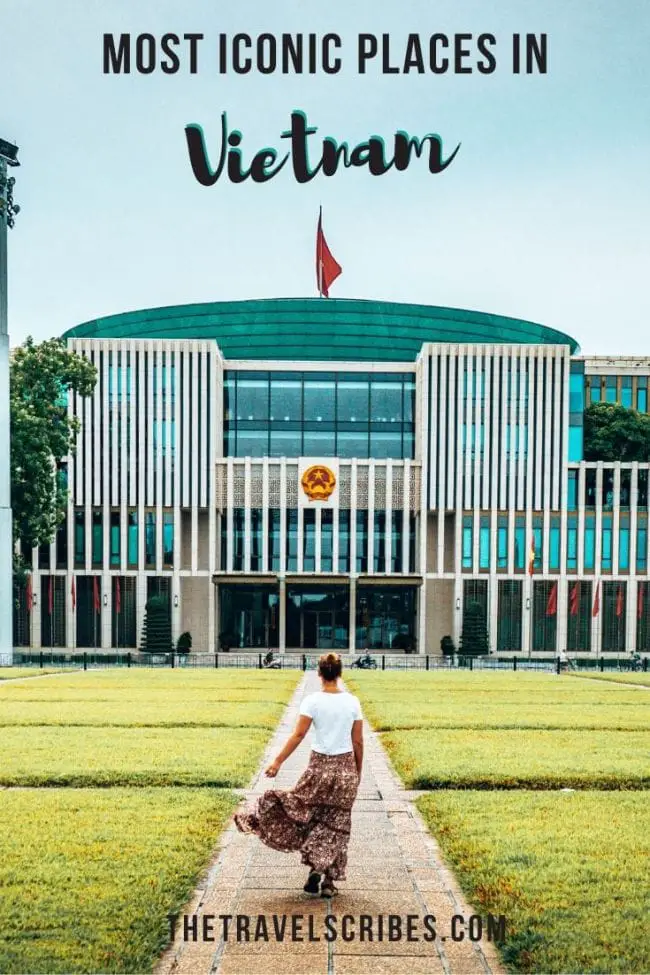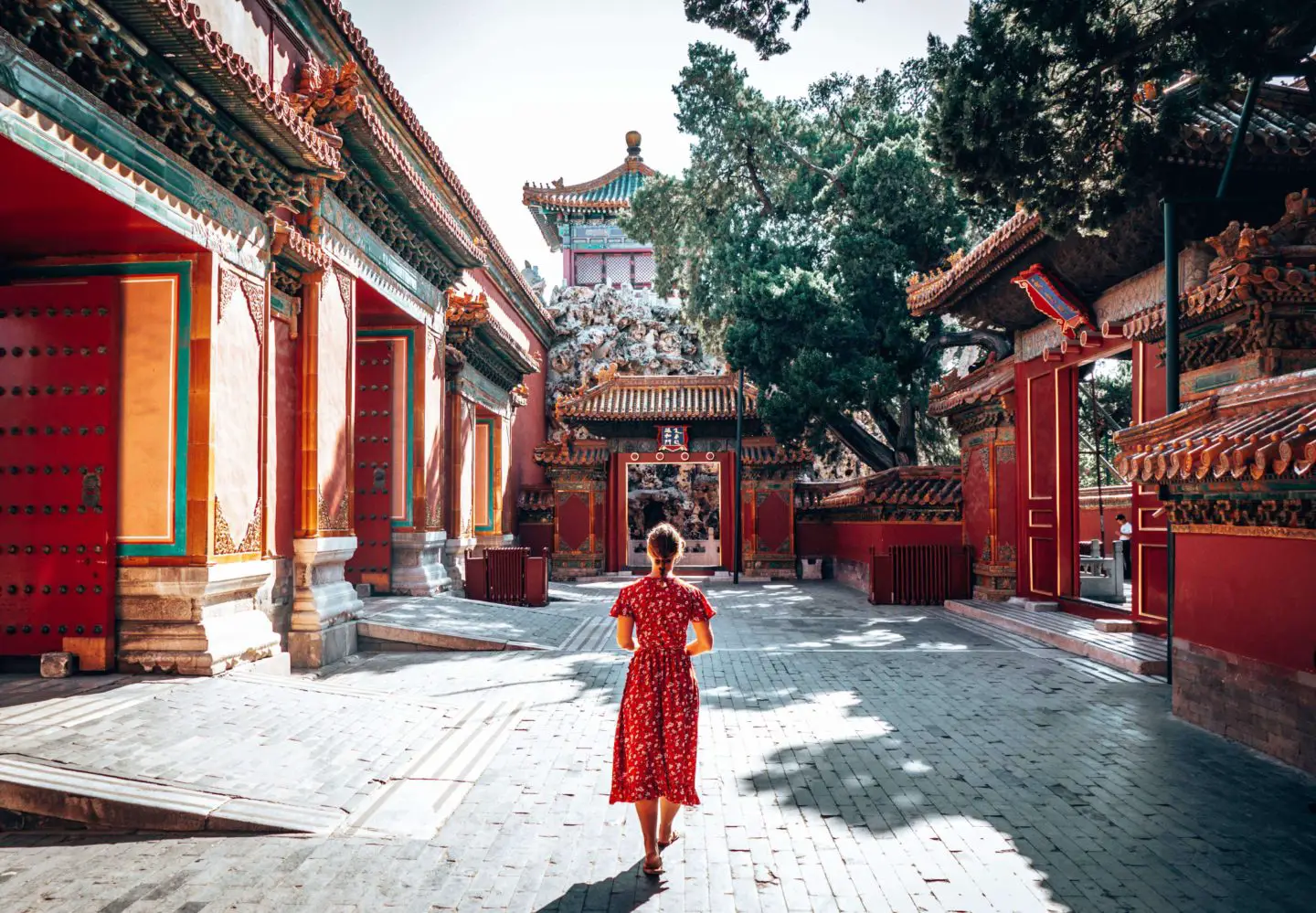From Hanoi to Ho Chi Minh City and Ninh Binh to Nha Trang, Vietnam is a country jam-packed with iconic places; both exquisite natural landscapes and soaring buildings and manmade structures. Whether its floating past the towering karsts of Ha Long Bay, tomb-hopping in Hue or exploring the Old Town of Hoi An, there are so many famous Vietnamese landmarks that you are spoilt for choice! To make sure we’ve covered them all, we asked other leading travel bloggers and wandering experts to help us count down the list of the top landmarks in Vietnam.
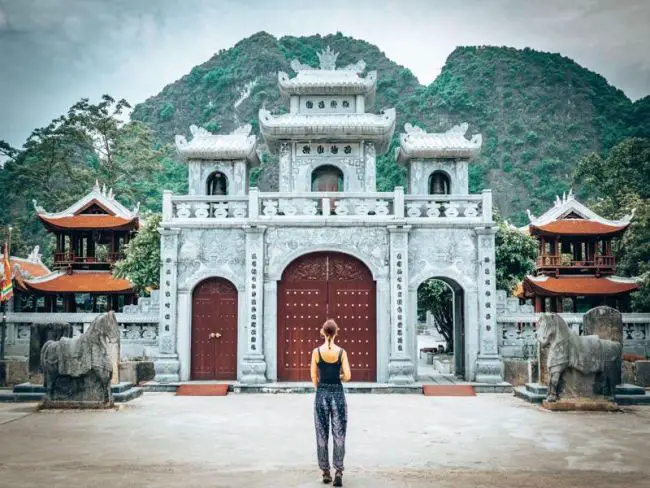
Skip ahead
The Top 10 Landmarks in Vietnam
- Ho Chi Minh Mausoleum, Hanoi
- Imperial City, Hue
- Cu Chi Tunnels, Ho Chi Minh City
- Ha Long Bay, Ha Long
- DMZ Bridge, Quang Tri
- The Old Quarter, Hanoi
- Khai Dinh Tomb, Hue
- Heritage Houses, Hoi An
- Ba Na Hills, Da Nang
- Son Doong Cave, Quảng Bình
Read next: Did any of these amazing landmarks make it onto the list of the most famous landmarks in the world?
Ho Chi Minh Mausoleum, Hanoi
Explored by John Paul from The Hangry Backpacker
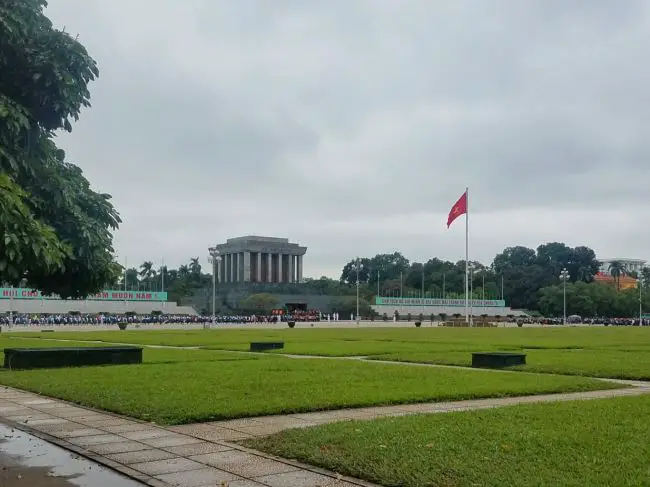
The Ho Chi Minh Mausoleum in Hanoi is one of the most popular tourist attractions in Vietnam’s capital city, drawing tourists and locals alike. The memorial, located in Ba Dinh Square, houses the preserved corpse of the famed Vietnamese revolutionary and leader who died more than 50 years ago.
Despite Ho Chi Minh’s wishes for his body to not be preserved like Lenin, there he lies – embalmed so that, according to the locals, he can ‘live forever’.
This huge granite edifice was constructed between 1973 and 1975, just a few years after Ho’s death in 1969. Created in the same style as that of Lenin, this rectangular building measures 70 feet high and 135 wide, making it a large monument that almost looms over the Ba Dinh square, incidentally the same square where he declared the country’s independence in 1945.
This giant tomb is highly regulated: You’re not allowed any pictures, you’re not allowed to stop moving and you’ll probably wait for at least an hour in line to get in, as the military has strict control over the site. That, said, visiting the mausoleum is a curious, if a little intimidating, experience.
Make sure to dress appropriately when visiting the site and time your visit right – it’s fairly busy at all times but particularly during any holidays, when the local population comes out in droves.
Khai Dinh Tomb, Hue
Explored by James from The Travel Scribes
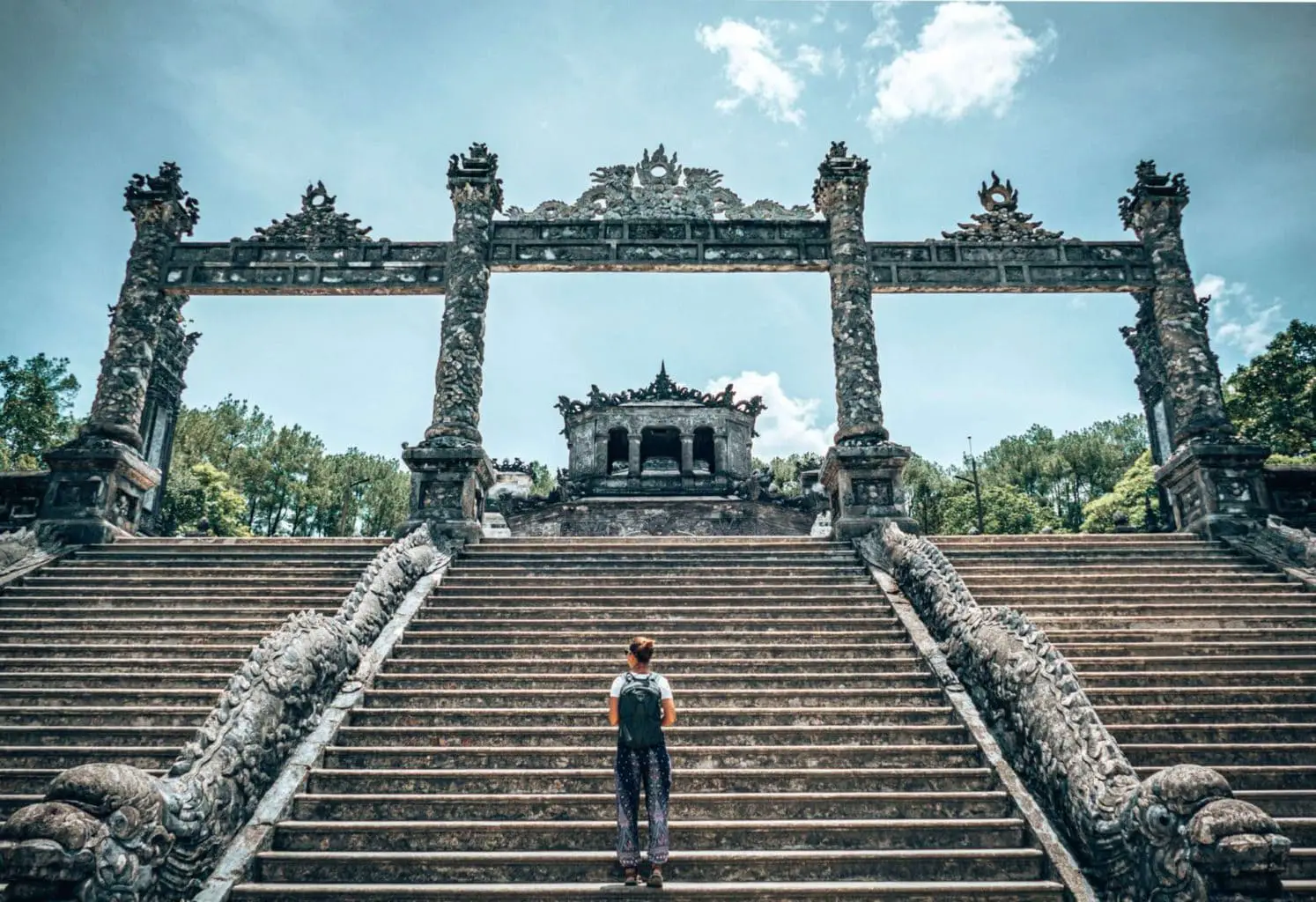
The historic city of Hue, often visited via train or car from neighbouring Da Nang or Hoi An, is home to a number of beautifully constructed tombs that are well worth a visit. The birthplace of the immensely powerful Nguyen dynasty that reigned over Vietnam from 1802 until the end of World War II in 1945, Hue was the capital city of Vietnam, a move by Emperor Gia Long to unite northern and southern Vietnam.
Other than Hue’s massive imperial city, the most visited attractions are the tombs of the Nguyen emperors, most notably the Khai Dinh, Minh Mang and Tu Duc tombs. And the crowning glory of them all? Probably Khai Dinh.
Constructed in 1925, this imposing tomb is the most elaborate (and popular) of the bunch, accessed by a hugely impressive staircase as you enter the property. This grandiose structure is in honour of Khai Dinh, the penultimate emperor of the dynasty who ruled from 1916 to 1925 as largely a puppet emperor, as Vietnam was truly controlled by the French. The tomb has a large courtyard – The Honour Courtyard – including watchful life-sized statues of guards of warriors, as well as a huge main building, Thien Dinh. The building includes a number of beautiful murals as well as an imposing statue of Khai Dinh himself, with his remains buried about 18m beneath it.
Related: Hue to Hoi An via the Hai Van Pass
Heritage Houses, Hoi An Old Town
Explored by Tamshuk and Ruzin from Tamz Explores
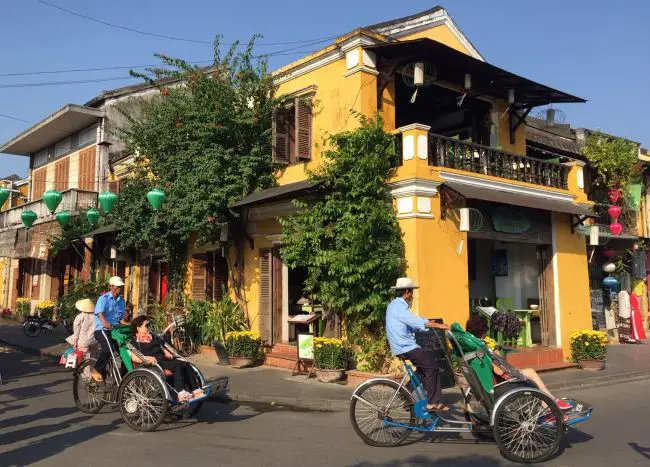
Hoi An, lovingly known as the City of Lanterns, in central Vietnam is a city unlike any other, especially in Southeast Asia. The city provides the perfect combination of a beautiful coastline, great food, a rich cultural heritage and a uniquely vibrant town.
However, it is the historic old town located in the center of the city that makes Hoi An one of the most popular travel destinations across the region and is also a UNESCO world heritage site. The major tourist attraction of the old town are the numerous heritage houses that are spread across the entire old town.
With a distinct yellow colour these houses were once home to the original settlers of Hoi An a few decades ago. Today, these houses have become landmarks in their own right, and many have since been converted to commercial and artistic establishments like cafes, museums, performing arts theatre and lantern workshops.
One of the most fascinating aspects to these houses is that the worn out looks on the exterior walls have been preserved beautifully which gives the entire place an old world charm. For the slow traveller, this place is perfect meandering through the lanes and exploring the unique vibes of these heritage houses. Being in the Hoi An old town is like taking a walk back in time to a bygone era.
Ba Na Hills, Da Nang
Explored by Jackie and Justin from Life of Doing
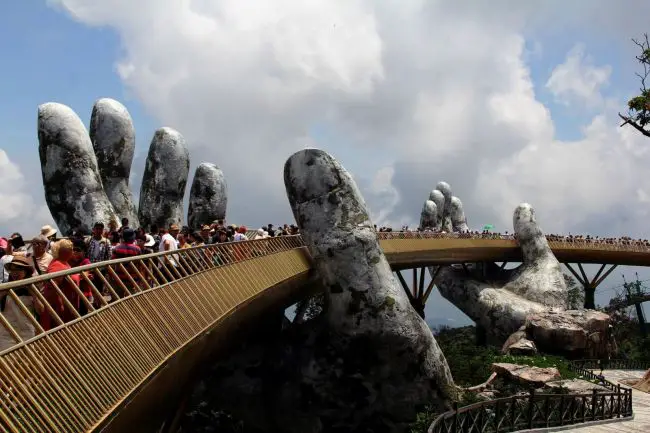
Out of all of the places that we visited in Danang, we loved our visit to Sun World Ba Na Hills. This European-inspired theme park and resort is a nice escape from Da Nang’s city life as it’s perched on top of the mountain at 1,487 meters (4,878 feet) high. When you first arrive at Ba Na Hills, the adventure starts by taking a 30-minute cable car ride to the main attractions.
Most visitors go to Ba Na Hills to walk across the iconic Golden Bridge. Once you exit the cable car station, you’ll see two giant stone hands holding up the bridge. In reality, the bridge isn’t long and gets quite crowded. If you want fewer people in your photo, it’s recommended to go there early in the morning before the tour groups arrive or later in the afternoon.
We enjoyed the other parts of the theme park such as the gorgeous gardens and the French Village with the facade of the churches and storefronts. Like with any theme park, visitors can watch musical shows and dancing, play games at Fantasy Park, eat European food, and go on rides. We recommend that you ride the alpine coaster so you can zip down the mountain. There is another side to the theme park that has a Buddhist temple and pagoda.
If you want to extend your stay and potentially have the whole theme park to yourself, consider staying overnight at the on-site Mercure Hotel.
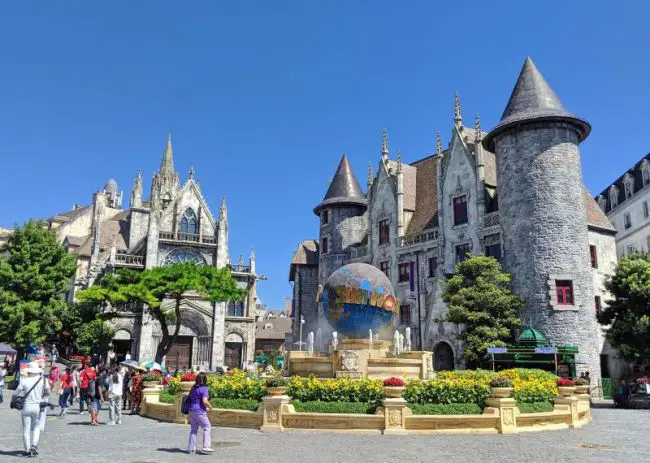
Domaine de Marie, Da Lat
Explored by Emily from Wander-Lush
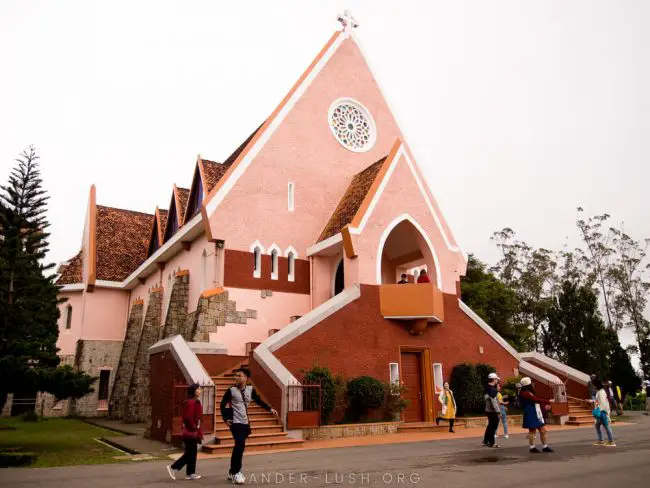
Once a French Colonial outpost, the city of Dalat in Southern Vietnam’s Central Highlands region is home to more than a few beautiful buildings and catholic churches. None is more iconic – or more Instagrammable – than the pretty Domaine de Marie.
Better known as ‘the cherry church’, Domaine de Marie is an active convent and kindergarten. It was established by an envoy of Saint Vincent de Paul Daughters who were sent to set down roots in then French-Indochina in the 1940s.
The building dates from this period, and follows an unusual combination of architectural styles of French, Vietnamese and K’Ho origin (the K’Ho are the ethnic group who traditionally inhabit this area). The pink limestone façade with brick and salmon-coloured detailing is divine, while the unusual shape of the roof reflects traditional stilt houses found throughout Central Vietnam. The most iconic view of the church is from the front, where its triangular shape is most pronounced. You might have to queue to get a photo on the pointed Juliet balcony!
The grounds are open daily from 8am and entry is free. Remember this is an active place of worship (you can also attend 5pm mass), so be respectful – no intrusive photos, no running, and no yelling. While you’re there, be sure to wander around the flower gardens, lovingly kept by the resident nuns. The hilltop location affords some nice vistas – don’t leave without wandering around the back for a view over the city.
Cu Chi Tunnels, Ho Chi Minh City
Explored by Lee from The Travel Scribes
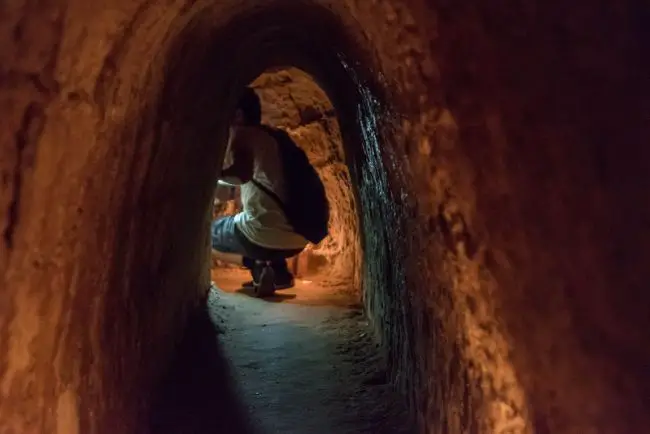
Photo Credit: Dronepicr / Flickr
A short day tour from Ho Chi Minh City is the must-visit site of the Cu Chi Tunnels. If you’re at all interested in the Vietnam War, you’ll want to head out to see the tunnels, which span about 121km (75 miles) in length. The tunnels housed the base of operations for the Viet Cong army back in the 1960s, as soldiers used them as small hiding places during the war.
However, more than just a way to stash themselves, the tunnels were handy for keeping supplies like food and weapons. They also served as make-shift hospitals or clinics for the wounded. The tunnels themselves are a bit cramped – you’ll definitely need to duck a few times if trying to squeeze through them – and so a great showcase of the basic conditions the fighters needed to endure during this time.
Bonus: If you’re in Ho Chi Minh City, definitely check out another landmark – the Notre Dame Cathedral – or book a day trip out of town for a river cruise on the mighty Mekong Delta, as part of your Vietnam itinerary.
Imperial City, Hue
Explored by Elisa from World in Paris
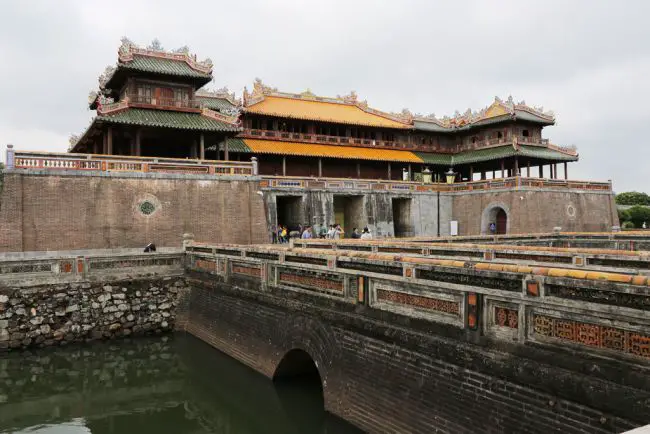
It’s one of the most interesting historic sites and landmarks in Vietnam: the Imperial City or the ‘Citadel’ of Hue and, most notably, the Royal Palace within it.
The city of Hue, located in Thua Thien province in Central Vietnam, was the seat of the Nguyen dynasty between 1802 and 1945, and the national capital of the country. As the seat of power, the kings wanted to build a magnificent palace to mirror their wealth and prowess, hence the construction of the Imperial city and the Palace, which was home to the royal family and their staff.
With each wall of the city stretching 2 kilometres, this massive complex is well worth a trip, even if parts of it were irreparably damaged through the country’s many conflicts.
Situated within the Hue Imperial City, the entrance to the Royal Palace is through a beautiful bridge that crosses the moat surrounding the Imperial City. The bridge is also one of the best spots for a picture. Inside, there are a number of different buildings, with the Thai Hoa palace – the place where the kings ruled – and Thai Mieu being the most important ones. Take your time strolling around these fascinating buildings, and don’t miss the surrounding gardens and ponds.
The One Pillar Pagoda, Hanoi
Explored by Lavina from the Continent Hop
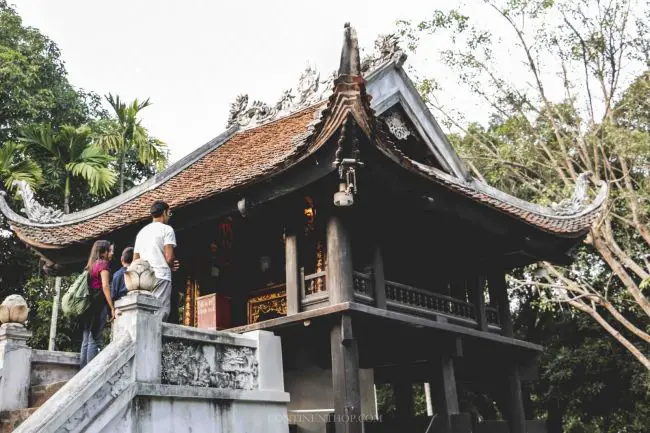
The One Pillar Pagoda located in the heart of Hanoi is situated in the park behind the museum near Ba Dinh Square. Alongside the Perfume Temple, it is considered to be one of the most important Buddhist sites in all of Vietnam. It is said that Emperor Ly Thai Tong built the temple in gratitude to the deity of mercy following the birth of his son.
Rising from a single pillar located in the centre of a lotus pond, it is crafted from wood and shaped to symbolise a lotus growing in a pond. And the statue of the Vietnamese Buddhist deity Quan Am is placed inside the small temple to whom it is dedicated. It is also said that the tree that grows behind the pagoda grew from a branch of the tree under which Buddha attained enlightenment.
Nowadays tourists flock to the pagoda to see the beautiful landmark but also to pray, as the act of prayer is said to bring health and fertility.
There are no entrance fees and the temple is open daily from 8 AM to 5 PM. However, as it is a temple, appropriate attire covering the shoulders and legs is required if you want to enter the temple complex. Not keen to go inside? You can of course just take a walk around the temple, and shoot a few snaps.
Ha Long Bay, Ha Long
Explored by Karolina from The Lazy Travel Blog
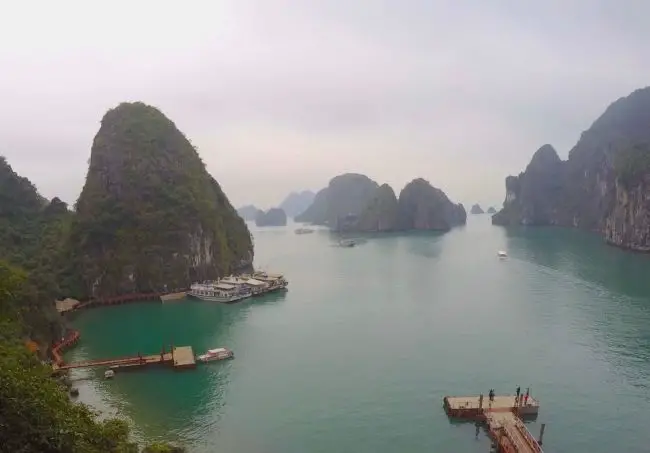
Ha Long Bay is one of the most iconic landmarks of Northern Vietnam. A must-do that should be a part of every Vietnam itinerary, a cruise on a traditional junk boat through the Gulf of Tonkin can be the most authentic experience you can have in Vietnam. Just imagine sailing through emerald waters as you view what looks a giant rock garden with the karsts that dot Halong Bay.
One of the biggest questions of would-be visitors is the length of time one should visit Halong Bay. Although a day trip is usually recommended, it is quite pleasant to stay on a junk ship overnight to have the pleasure of seeing the bay during sunrise or sunset.
As much as the spectacular formations of The Surprise Cave and the stunning vistas of Tip Top Island are the highlights of the tour, there is no better way to experience Halong Bay than to catch it during first light when you catch the misty scenery that is a stereotypical representation of Asia in films. There is also something serene about watching the karsts pass as you lay on one of the lounge chairs on top of the boat or kayak through the stunning bay.
Related: Bai Tu Long Bay Cruise – which one to choose.
Dragon Bridge, Da Nang
Explored by Yen from Wandering Journal
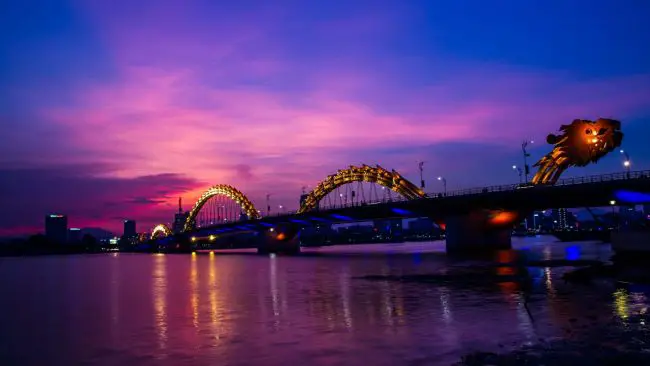
At the length of 666 meters, the Dragon Bridge is the longest bridge ever constructed in Vietnam. Since ancient times, the people believe that a dragon is a symbol of power, nobility and good fortunes. This landmark of Da Nang also signifies the growing economy of Vietnam especially in this rising city of Da Nang.
While there are several bridges connecting the eastern part of the city to the western part, Dragon Bridge appears to be the most attractive. That being said, other bridges, including Dragon Bridge do put on vibrant light shows every night too.
To catch a closer glimpse at the bridge’s light show at night while enjoying the sea breeze at night, there is a huge walkway near the ‘entrance’ of the bridge. Bring a Banh Mi and have your meal at one of the benches there! If you’re planning on walking through the bridge, it’s totally possible. Unlike many other huge bridges in the world, there is actually a walkway in Dragon Bridge for pedestrians.
For those who want to save money, it’s totally doable to walk all the way from the airport to My Khe Beach. Most people stay in the western part of the city, where all the beaches are located.
Hao Lo Prison Museum, Hanoi
Explored by Hannah & Adam from Getting Stamped
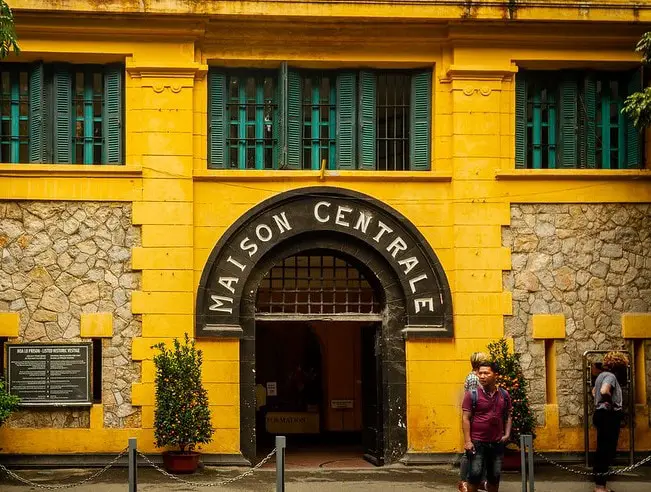
Photo Credit: rhjpage / Flickr
Hanoi, the capital city of Vietnam, is the country’s second largest city and full of several iconic landmarks and buildings. One of those best places to visit in Hanoi is the Hoa Lo Prison Museum, which is also known as the “Hanoi Hilton.”
Originally built in 1896 by the French, it was intended to house political prisoners and only hold around 450 prisoners. However, by the 1930s, there were said to be over 2,000 prisoners. During the Vietnam War, North Vietnam used the prison for prisoners of war, including Americans.
The prison you’ll see today is only the small southern section of the entire complex. In 1997, most of the prison was demolished to make room for the Hanoi Central Tower building, which is now an office and hotel complex.
Throughout the museum, you’ll see life-size mannequins of prisoners, various boards that explain the history and footage about how the prison operated. The museum is definitely worth a visit to learn about its past.
Ha Giang Loop, Ha Giang
Explore by Luke from The Coastal Campaign
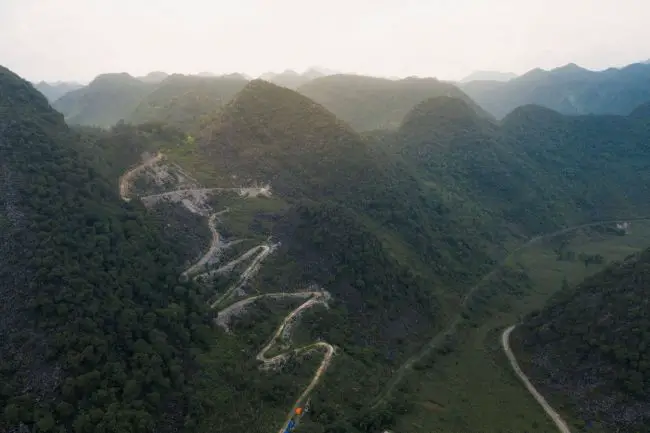
The Ha Giang Loop in Vietnam is an epic 3-4 day road trip through the remote mountains of Northern Vietnam. It is the perfect place to visit if you are looking to get off the beaten path and discover the more rugged and rural parts of the country.
The loop starts and finishes in the town of Ha Giang, where you can either rent your own motorbike and drive yourself, or join an organised easy rider tour where you sit on the back of a motorbike driven by a local. The roads here are quite narrow and windy so you will need some experience riding a bike in order to drive yourself.
The scenery on this road trip is breathtaking as you drive high into the mountain peaks and along the valley floors. This route also takes you right along the border with China. As well as amazing mountaintop views, it is awesome to get a snapshot of how the locals live in the more rural areas. It feels like taking a step back in time as you drive through these remote places.
It really is an amazing adventure to drive through the mountains of Northern Vietnam and the views around every corner are absolutely mesmerising, made even more special since few tourists make it up there.
Phu Quoc, Kiên Giang
Explored by Lee from The Travel Scribes
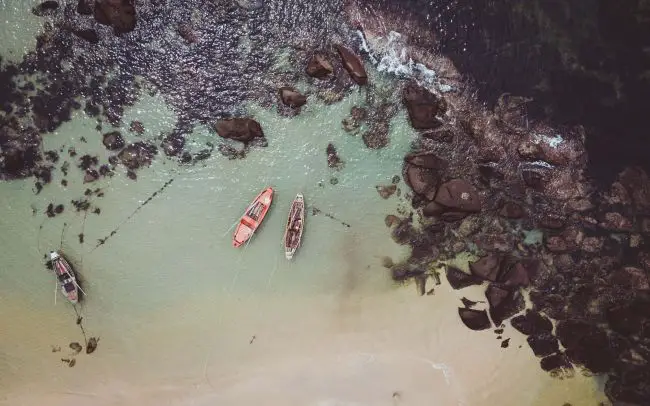
It’s theoretically closer to Cambodia, but Phu Quoc is one of the island gems of Vietnam. Think pristine white sands, azure waters and relaxation; all things that don’t immediately come to mind when you think of the hustle and bustle of Vietnam.
Technically Phu Quoc isn’t one island, it’s 22 of them! The islands, all set within the Kiên Giang Province, offer up an idyllic vacation experience where you can choose anything from a premium, private resort to a more basic backpacking experience. The main island is Phu Quoc itself, the largest island in Vietnam spanning over 500 square kilometres!
Many tourists are also attracted to one of the area’s most remote islands, Hon Xuong. Also known as Robinson Crusoe island, after the book of the same name, this paradise spot can only be reached via boat for the day. The second largest island in the district, Hon Thom (known informally as Pineapple Island) is also a great day trip as its accessible via the world’s longest oversea cable car, stretching 8 kilometres across the ocean.
White & Red Sand Dunes, Mui Ne
Explored by Joanna from The World in my Pocket
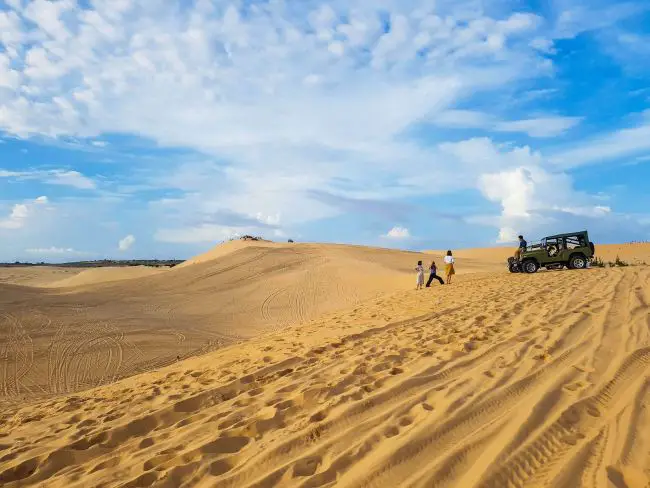
Most tourists spend only one day in Mui Ne, mainly to see the famous white and red sand dunes, located just outside this little Vietnamese seafront town.
The white dunes (also known as Bau Trang or White Lake) are located 25 kilometres away from the village, reachable in about 30-40 minutes by car. One of the most exciting things to do at the white dunes is to explore them by quad bike. You can rent one at the visitors centre, either to drive yourself or with a driver. If you are traveling with friends, you can pitch in together and rent a jeep with a driver for some good old dune bashing fun. Remember that if you are on a tour you will have limited time at the white dunes, whilst if you go on your own you can explore for as long as you wish.
The red dunes are located on the outskirts of Mui Ne and are best visited at sunset, when the sun reflects into the sand and intensifies its color. The best thing to do here is to slide down the dunes on a small plastic sled. There are many women at the bottom of the dunes renting these for a small fee. The higher you climb the dunes, the better the view is, as the ocean is just a stone’s throw away.
There are two ways to explore the dunes: on your own, by renting a motorbike, or with an organised tour that pretty much every hotel in the area can organise (although check the reviews first!).
Van Long Nature Reserve, Ninh Binh
Explored by Penny from The Globe Trove
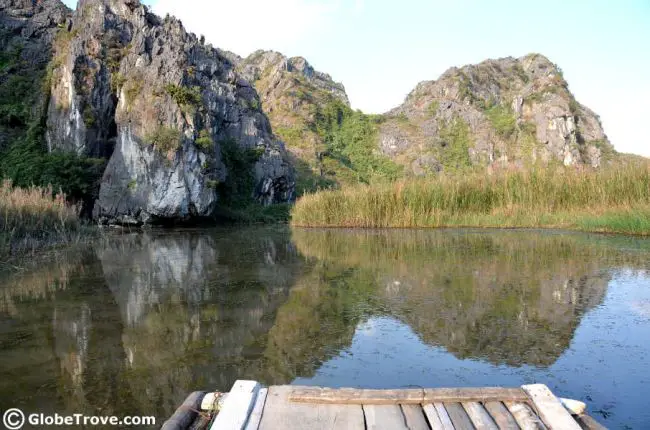
Ninh Binh is one of the popular spots that people visit in Vietnam and it is largely due to the gorgeous landscape. Many people call it the Halong Bay on land and one of the country’s most beautiful landmarks. This is because of the lovely karst landscape that captures your attention no matter which part of the country you head to.
There are three iconic spots which you can head to in order to truly immerse yourself in this experience. They are Trang An, Tam Coc and Van Long Nature Reserve. Each one of the three has its own charm but both Tam Coc and Trang An have a cave system which you explore on a boat. Van Long Nature reserve however is a little further away from Ninh Binh than these two spots. The idyllic nature reserve in the Vietnamese countryside is away from the hustle and bustle that the cities of Vietnam are famous for, and a great place to escape to for a few days.
The Van Long Nature reserve is a great place to watch the local bird population in action. If you’re thinking of heading to this slice of paradise, try to get there either early morning or towards dusk as that is when the birds are most active. It is a real pleasure to watch them swoop in and out of the water and the silence of the nature reserve is such a soother too!
Cai Dai Temple, Tay Ninh
Explored by Wendy Werneth of The Nomadic Vegan
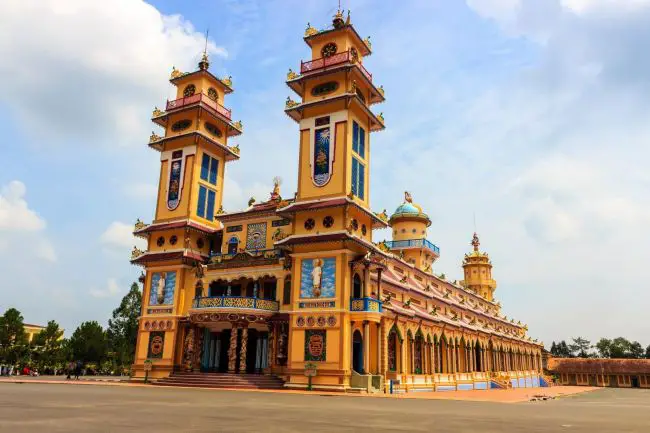
Vietnam has quite a lot of religious diversity for a country where the majority of people profess to be atheists. One of its local religions that you’ve probably never come across anywhere (or even heard of) is Caodaism, which is followed by about five percent of the Vietnamese population. Followers of Caodaism promote world peace and unity. Like most Buddhists in Vietnam, they follow a vegetarian diet, at least on certain days of the month.
There are a number of Cao Dai places of worship throughout the country, but the most important one is known as the Great Divine Temple. This famous Vietnam landmark is located about 90 kilometres outside of Ho Chi Minh City, towards the Vietnam Cambodia boarder.
Caodaism is quite an eclectic religion that draws from both Western and Asian influences, and this mix is evident in the extraordinary architecture of the temple. Esoteric symbolism abounds, such as the “divine eye” painted on a huge sphere and surrounded by columns entwined in curling dragon’s tails. The brightly coloured gowns of the worshippers also add to the spectacle. While the laypeople dress in white, the priests dress in bright yellow, blue or red, depending on their rank.
Visitors are welcome to attend the ceremonies that are held four times each day, and you can even take photos from the second-floor gallery. Be sure to dress appropriately, which means long pants or, for women, a skirt that reaches below the knee.
Demilitarized Zone (DMZ), Quang Tri
Explored by Oli from Not Brits Abroad
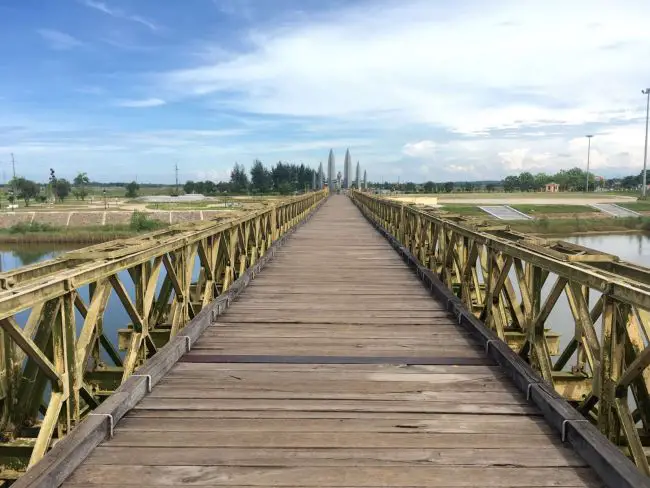
During the Vietnam War, the north and south were divided along the Ben Hai River around 100km north of Hue. The areas close to the river border acted as the demilitarized zone during the conflict and today you can visit the old bridge crossing, Cầu Hiền Lương which connected the divided country.
Aside from the blue and yellow border bridge, there are plenty of other historic war sites in the area. One of the nearby highlights is the Vinh Moc Tunnels which were built by the local Vietnamese as a shelter from American bombs. They were inhabited in for over five years and go as deep as 23 metres underground.
Other sites spanning the DMZ area include the Ho Chi Minh Trail, the route taken by the North Vietnamese to enter the south, and Khe Sanh Combat Base, a former US base close to the border with Laos. At Khe Sanh, there are a number of old military vehicles and a museum which documents the significance of the base.
Although you can visit all of the sites with your own transport, I highly recommend taking a private day tour from Hue with a Vietnam War veteran. With a veteran, you get a special insight into each site and hear about their experiences during the war. Taking a tour of the Demilitarized Zone with a veteran is sure to fascinate anyone with an interest in the war, even if it isn’t the most light-hearted of activities.
My Son Sanctuary, Quảng Nam
Explored by James from Where You’re Between
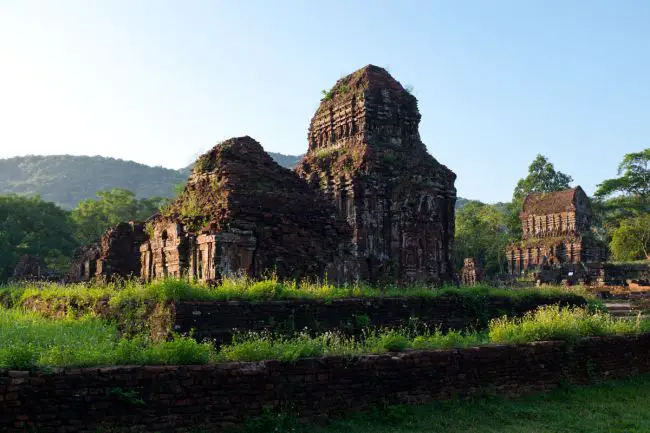
Located in a wide valley beneath the mountain ranges that lie around an hour’s drive from Hoi An, My Son is a fascinating collection of ancient Hindu temples that were built between the 4th and 14th centuries.
The temples of My Son Sanctuary were built and renovated by a series of kings from the Cham dynasty over hundreds of years. Each temple is dedicated to a Hindu god and were usually built to mark the ascendancy of a new king to the throne.
Following the decline of the Cham dynasty, My Son was largely forgotten about hundreds of years. Rediscovered in the late 19th century, today My Son is a UNESCO World Heritage Site and wonderful landmark in Vietnam. There are thought to be around 70 temples in My Son. Ravaged by nature following centuries of neglect, and also heavily bombed during the Vietnam War, there have been many attempts to restore and preserve much of what remains at My Son.
My Son’s temple ruins still bear many of their original features, including inscriptions in ancient texts and statues of Hindu deities. Also still visible are the large craters left behind by the bombs that fell here during the Vietnam War.
There are several companies that offer tours of My Son from Hoi An. An early morning tours is highly recommended, offering the chance to see My Son without the crowds whilst also meaning you can tour the site in the relative cool of the morning before the temperature really heats up.
Ba Be Lake, Bac Kan
Explored by Josh and Sarah from the Veggie Vagabonds
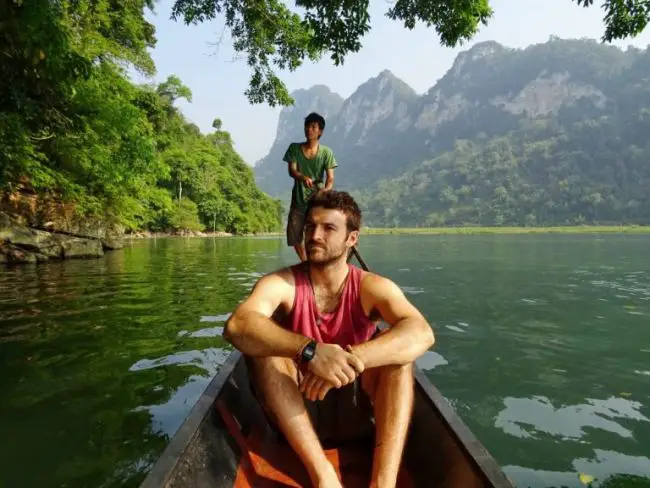
After spending a year living in Hanoi and travelling as much as possible, we were fortunate to explore a huge amount in the north of the country. One place which really stuck in our minds was Ba Be Lake, the largest natural lake in the country and an absolutely stunning area if you’re looking for nature.
Whilst Hanoi is a truly invigorating city, for nature lovers, it leaves a lot to be desired. Ba Be on the other hand, and the national park that surrounds it, is an absolute oasis of wildlife, plants and living organisms.
Around the area there are many hikes which take you up across the valleys, through to traditional villages and past flowing waterfalls. The whole area is so lush and green, it’s a beautiful contrast from the metropolis of Hanoi. If visiting, we’d highly recommend going on one of the traditional boats to explore the lake ecosystem.
The lake is also home to a famous Vietnamese fairy tale. Legend has it, there was an old woman who was shunned by the local villagers, only to be helped by a kind-souled mother and son. It turned out this old woman was actually a fairy that was trying to warn the villagers that a great flood was going to come. Nobody believed her apart from the good-hearted mother and son, who built a boat in preparation. Days later a huge storm flooded the village and it was only the single boat which could save people. That flooding is said to be the beginnings of Ba Be lake!
Hang Son Doong Cave, Quảng Bình
Explored by James from The Travel Scribes
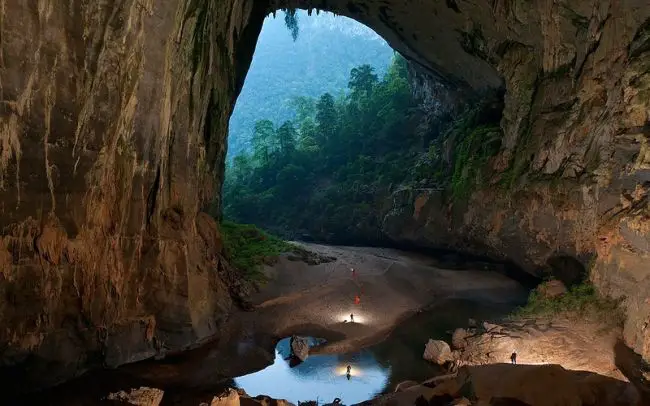
Photo Credit: Dante Aguiar / Flickr
It’s undoubtedly a legendary landmark in Vietnam: the world’s largest cave, Son Doong!
Discovered by accident by a local man back in 1990, he had been wandering Phong Nha-Ke Bang National Park for food when he came across clouds coming from the entrance and the sounds of a river within. Later, in 2009, he returned with two cave explorers who realized they had come across a mammoth cave; the largest on the planet. It’s so big that you could fit an entire block of New York City inside the main chamber!
This 3 million year old cave is 9 kilometres in length, with the main passage measuring approximately 38 by 10 cubic metres large, 5 kilometres long and 200 metres high. It also boasts some of the world’s largest stalagmites, some of which are 70 metres tall, and gigantic cave pearls (usually small, spherical limestone balls), as big as baseballs!
The Old Quarter, Hanoi
Explored by Claudia from My Adventures Across the World
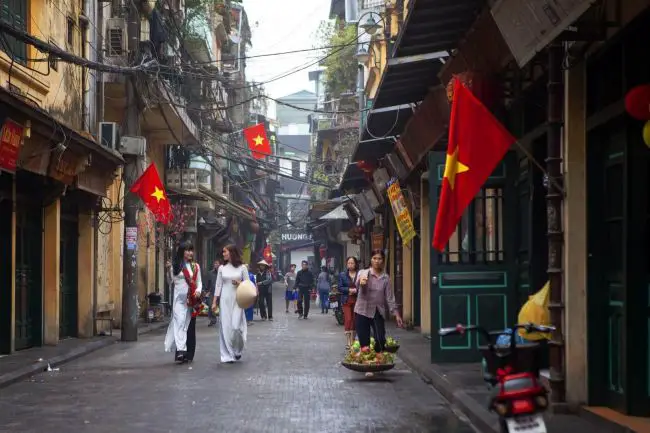
One of the nicest things to do in Hanoi is exploring its Old Quarter. The historic and commercial heart of Vietnam’s capital is chaotic, yet charming and packed with interesting attractions. You will find pagodas, temples, and beautiful looking buildings that are great examples of French colonial architecture. All of them worthy to be on the list of Vietnam landmarks!
Among the unmissable landmarks in Hanoi Old Quarter there are Hoan Kiem Lake, the Opera House, the National Museum of Vietnamese History, Ba Dinh Square, the One Pillar Pagoda, the Thang Long Water Puppe Theater and Hanoi’s largest market which is called Dong Xuan.
The best way to take it all in is to simply walk around. This way, you will come across the myriad of bars, restaurants and all the tiny street food places which are perfect for a bite. You will be able to see lovely boutiques, art galleries and even old jewelry shops.
This part of town gets incredibly busy at nighttime so make sure to go there for a drink or an evening meal!
Mind you – walking around Hanoi Old Quarter is not exactly a stroll in the park. Much like the rest of the city, this part of town is crowded and you will have to dodge your way around the traffic of motorbikes, scooters and bikes. Yet, the energy is incredible and you’ll end up loving it.
Related: Ultimate 4 day Hanoi Itinerary
Marble Mountains, Da Nang
Explored by Disha from Disha Discovers
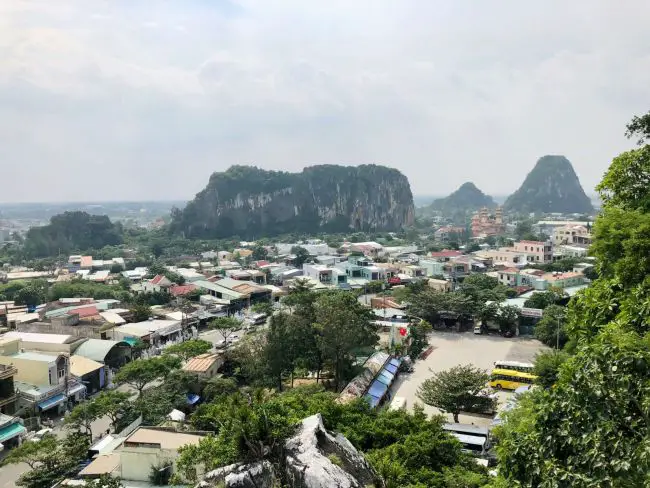
Vietnam has so many incredible places to visit and natural landmark, with the Marble Mountains being one of them.
The Marble Mountains are a popular day trip from Hoi An or Da Nang. Essentially, they’re a group of five hills made out of limestone and marble. Each mountain is named after a natural element: fire, water, wood, metal or gold, and earth. The story behind the Marble Mountains is that a dragon emerged from the water and laid an egg. The mountains were created from the fragments of the egg when a girl hatched from it.
There are several caves, temples, and tunnels that you can explore. There is an entry fee, but it’s relatively cheap. There is an additional surcharge for using the elevator if you’re not keen on walking up the stairs. I used the elevator, but my husband said that the stairs weren’t too bad. With that being said, be sure to wear breathable and comfortable clothing it can be extremely hot.
I highly recommend spending around four or five hours here to be able to fully explore and starting earlier in the morning to avoid the heat. If you go during the rainy season, be careful because the stairs can get slippery.
So what do you think of our list of iconic building and landmarks in Vietnam? Are there any that we have missed? Let us know in the comments below if you have any alternative suggestions.
If you’re interested about other famous landmarks in Asia, we’ve created a number of guides, have a look through to see what iconic places made the lists!
- 21 Iconic building and landmarks in Singapore
- 15 Iconic Sri Lankan Landmarks
- Famous places in Myanmar
- Top 10 landmarks in China
- The ultimate Indonesia landmarks
- Thailand’s 21 most iconic places
- Iconic places and famous landmarks in Malaysia
And if you’re inspired to visit some of these sites, why not check out our 3 week itinerary on the country – with everything you need to know about planning a trip to Vietnam.
Want to save this for later? Why not pin it…
